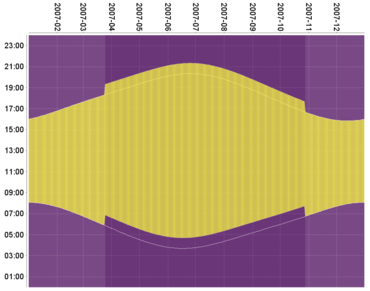उन्हाळी प्रमाणवेळ
उन्हाळी प्रमाणवेळ (किंवा ग्रीष्म प्रमाणवेळ) (इंग्लिश: Daylight saving time, summer time) ही जगातील अनेक देशांमध्ये उन्हाळ्यामधील स्थानिक प्रमाणवेळ आहे. विशेषतः शीत कटिबंधांमधील भागात उन्हाळ्यातील जास्त काळ टिकणाऱ्या सूर्यप्रकाशाचा फायदा घेण्यासाठी दरवर्षी वसंत ऋतूमध्ये स्थानिक वेळ एक तास पुढे ढकलली जाते व उन्हाळा संपल्यानंतर साधारण शरद ऋतूमध्ये ही वेळ एक तास मागे केली जाते. जॉर्ज व्हरनॉन हडसन ह्या न्यू झीलंडच्या शास्त्रज्ञाने १८९५ साली उन्हाळी प्रमाणवेळेची संकल्पना मांडली.
युरोप व उत्तर अमेरिकेतील बहुसंख्य देश उन्हाळी प्रमाणवेळ वापरतात.


उन्हाळी प्रमाणवेळेच्या वापराबाबत तज्ज्ञांमध्ये दुमत आहे. उन्हाळ्यात घड्याळ पुढे केल्यामुळे ऊर्जेची बचत होते असा समर्थकांचा दावा आहे तर शेतकऱ्यांना ह्या पद्धतीचा त्रास होतो अशी विरोधकांची भूमिका आहे.
Origin
[संपादन]


G.V. Hudson invented modern DST, proposing it first in 1895.



Benefits and drawbacks
[संपादन]




बाह्य दुवे
[संपादन]- उन्हाळी प्रमाणवेळेचा इतिहास Archived 2007-09-18 at the Wayback Machine.

